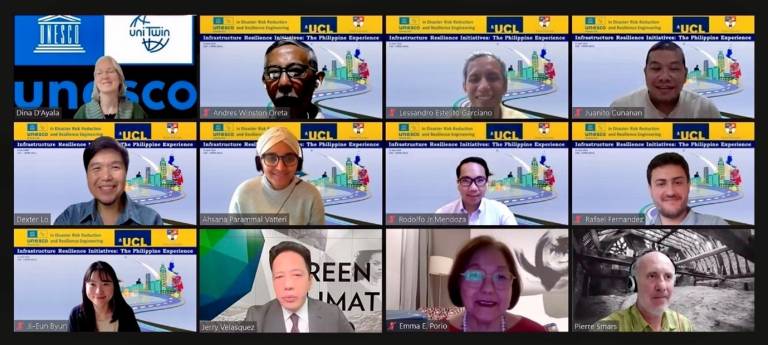UNESCO Chair webinars: Infrastructure Resilience Initiatives - The Philippine Experience
19 April 2024
The UNESCO Chair in Disaster Risk Reduction and Resilience Engineering, in collaboration with Xavier University - Ateneo de Cagayan (XU) in the Philippines, recently delivered a webinar showcasing the country's experience with infrastructure resilience.

According to the 2023 World Risk Index Report, the Philippines is the most at-risk country in the world. In particular, typhoons, floods, and earthquakes continue to hit the country causing destructive impacts to infrastructures. Meanwhile, Philippine engineers and scientists work tirelessly to advocate, adapt, and advance the resilience of infrastructures in the country.
To showcase these innovations and practices, the UNESCO Chair in Disaster Risk Reduction and Resilience Engineering in collaboration with the Social Development Office of Xavier University - Ateneo de Cagayan (XU) in the Philippines, jointly hosted a webinar called: Infrastructure Resilience Initiatives: The Philippine Experience.
The webinar featured frameworks, projects, and experiences in promoting and implementing resilient infrastructures in the country. Dr. Oreta, a Fellow of the Association of Structural Engineers of the Philippines (ASEP) shared the DMPR Training Program, which is being rolled out to engineers nationwide. Dr. Garciano, also an ASEP Fellow, shared valuable lessons learned from ASEP’s actual post-earthquake case studies and field reports. Engr. Cunanan’s talk outlined the Philippine Government’s efforts in making public buildings in Metro Manila resilient to the “big one” – an earthquake scenario that could potentially hit the metropolis.
Dr. Vatteri, a Research Fellow at UCL who works with a team in XU, presented their ongoing project on the assessment of school buildings in Cagayan de Oro City, against earthquakes and floods. Their work also features the systems interaction of transport infrastructures and buildings in the aftermath of a disaster. Dr. Mendoza’s talk featured his innovative project for the structural evaluation and intervention of the Bantay Church in Ilocos. The church was established in the 1590s and was heavily damaged during World War II. It was rebuilt in the 1950s.
Three reactors, Dr. Byun of the University of Glasgow, Dr. Velasquez of the Green Climate Fund, and Dr. Porio of the Ateneo de Manila University, shared their views and reactions of the topics presented. They also presented pathways for further collaborations to improve the technologies and strategies for ensuring resilient infrastructures.
A special presentation was also delivered by Dr. Smars about his field reconnaissance of the recent Hualien Earthquake in Taiwan.
During the webinar, the Q&A box was full and active of exchanges between the participants and resource persons. The webinar got a high evaluation rating of 4.6 (out of 5), with over 800 registrants worldwide. The video recording can be viewed here:
 Close
Close

